A return to the CAT Museum
A RETURN TO THE CAT MUSEUM: Last week, a group of us revisited the Cafesjian Art Trust Museum to view their new exhibit—From Origins to Horizons: The American Studio Glass Movement. I just love the CAT, not only for the fascinating pieces on display, but also for the atmosphere. It is a one-level building, small for what one typically thinks about as an art museum. It is quiet and relaxing, contemplative even. The museum is free, but the hours are limited, and reservations are a must. It is not crowded. Tours of sixteen to twenty people are scheduled and led by a well-informed guide. If you would like more information about the museum, please visit https://cafesjianarttrust.org/
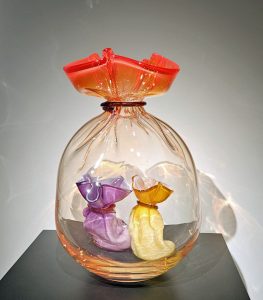 We had an exceptional guide in Bob who explained in detail the different processes of producing glass artwork. For example, Bagged Bags, 1981, by John Littleton and Kate Vogel, “blown, hot-worked, and hot-assembled glass” (from exhibit signage). Bob explained that the two inside bags were made first and kept at a precise temperature. I like to think of it as a Goldilocks’ temperature—not too hot and not too cold. Then the outer bag was blown to as thin as it could be without collapsing. The inner bags were placed on the bottom of the outer bag before it was shaped into the finished product. A work of this kind takes tremendous skill, patience, and years of experience to produce. Of course, Bob’s explanation was more technical than what I have written here.
We had an exceptional guide in Bob who explained in detail the different processes of producing glass artwork. For example, Bagged Bags, 1981, by John Littleton and Kate Vogel, “blown, hot-worked, and hot-assembled glass” (from exhibit signage). Bob explained that the two inside bags were made first and kept at a precise temperature. I like to think of it as a Goldilocks’ temperature—not too hot and not too cold. Then the outer bag was blown to as thin as it could be without collapsing. The inner bags were placed on the bottom of the outer bag before it was shaped into the finished product. A work of this kind takes tremendous skill, patience, and years of experience to produce. Of course, Bob’s explanation was more technical than what I have written here.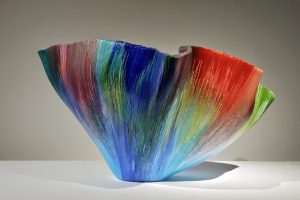
Promuovere Serena, 2000, by Toots Zynsky. “Zynsky is best known for a technique she developed called filet de verre that fuses together thousands of thin glass threads” (from exhibit signage). Bob explained how minerals, or pigments made from metal salts, help determine the color of glass. To learn more about the chemistry of adding color to glass, see https://www.thoughtco.com/the-chemistry-of-colored-glass-602252
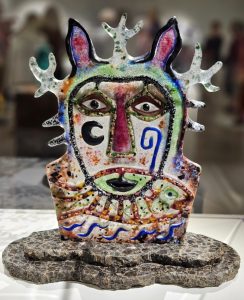 Deerman with Fish, about 1985-1995, by Ruth Brockmann, “cast glass and granite. Her work incorporated symbolism from different cultures and ancient myths…” (from exhibit signage). Bob pointed out that this stand-up mask was produced by putting chunks of glass into a mold and then placing it in a kiln.
Deerman with Fish, about 1985-1995, by Ruth Brockmann, “cast glass and granite. Her work incorporated symbolism from different cultures and ancient myths…” (from exhibit signage). Bob pointed out that this stand-up mask was produced by putting chunks of glass into a mold and then placing it in a kiln.
Memory, 1994, by Mary Shaffer, “slumped glass and metal” (from exhibit signage). I looked at this piece for a long time imagining how hard it must have been to use molten glass to achieve the final product. 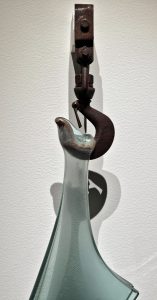
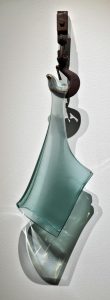
Untitled, 2003, by Dane Marioni, “blown reticello glass. This vessel shows the reticello technique, in which a net-like pattern is created on the surface and a small air bubble is trapped in each diamond shape” (from exhibit signage).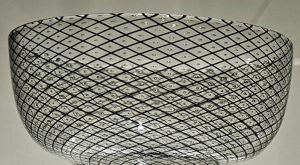
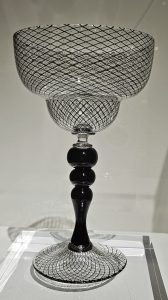
There were many more pieces in this exhibit, so if you found this blog interesting please visit either the museum or their website. Also, photos of some of the works in the first exhibit I attended at the CAT Museum can be found in my previous blog https://www.kathryntokarhaidet.com/2023/12/13/the-cat-the-a-is-for-art/


